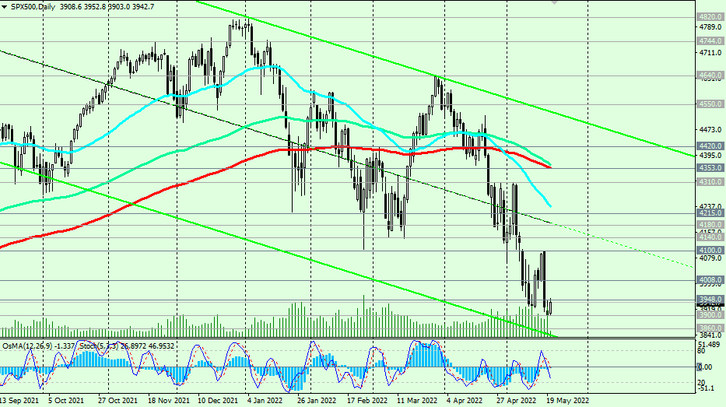Market participants continue to evaluate the results of the recent meeting of the Fed and the statements of Fed Chairman Powell, made by him this week. "We need to see a convincing reduction in the inflation rate. Until we see that, we will continue what we started," Powell said Tuesday, speaking at the Wall Street Journal-sponsored Future of Everything festival.
If inflation continues to rise, and there are a number of fundamental reasons for this (primarily rising energy and food prices), then the dollar will be under more significant pressure.
At the time of publication of this article, futures for the DXY dollar index are near 102.94, 212 points below the local maximum since January 2003 105.06, reached at the end of last week. This week DXY is likely to close in negative territory.
Today, one can also observe the growth of futures for major US stock indices. Thus, futures for the broad market index S&P 500 are currently traded near the mark of 3942.0, 82 points above yesterday's low of 3860.0.

So far, it looks more like a correction after a strong fall the day before and profit taking in short positions. But it also contributes to the weakening of the dollar.
Until the middle of next week, the economic calendar is not scheduled to publish important macro statistics for the US. We are likely to see a continuation of the weakening of the dollar. Volatility in its quotes may rise again on Wednesday, when fresh data on orders for durable goods and capital goods, implying large investments, and minutes from the May Fed meeting, following which Fed leaders decided to raise rates by half a percentage point, which was the largest increase since 2000, are published. Fed officials also announced that a three-month program to reduce the balance sheet, which reached $9 trillion, will begin on June 1 (balance reduction is one of the components of the monetary policy normalization program that the Fed is implementing to slow down inflation).
If the minutes contain new and unexpected information regarding the prospects for the Fed's monetary policy, then the volatility in dollar quotes, as we noted above, will increase.
A tougher tone of protocols will help strengthen the dollar. And, on the contrary, the soft rhetoric of statements by members of the Fed leadership will contribute to the weakening of the dollar.
And for today (for the American trading session) the publication of important macro data in the economic calendar, including for the United States, is not planned. Probably, the dynamics of the dollar until the end of today's trading day can be characterized as flat with a tendency to decline, especially if the American trading session opens with growth on the US stock exchanges.





